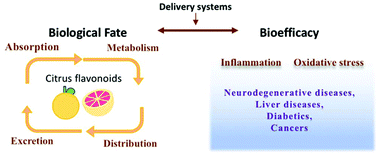The biological fate and bioefficacy of citrus flavonoids: bioavailability, biotransformation, and delivery systems
Abstract
Citrus fruits are among the most popularly consumed fruits worldwide, including oranges, grapefruits, pomelos and lemons. Citrus flavonoids such as hesperidin, naringin and nobiletin have shown an array of health benefits in cell, animal and clinical studies, including antioxidative, anti-inflammatory, neuroprotective, anticancer, and anti-obesity activities. Citrus flavonoids have limited bioavailability after oral administration, leaving the major part unabsorbed and persisted in the colon. Recent studies have highlighted the important role of the gut microbiota and in vivo biotransformation on the bioactivity of citrus flavonoids. This article discusses the biological fate of citrus flavonoids from the viewpoint of their absorption, distribution, metabolism and excretion in vivo. Many delivery systems have been designed to enhance the oral bioavailability of citrus flavonoids, such as emulsions, self-emulsifying systems, nanoparticles and solid dispersions. The ultimate goal of these delivery systems is to enhance the bioefficacy of citrus flavonoids. Several studies have found that the increased bioavailability leads to enhanced bioefficacy of citrus flavonoids in specific animal models. Regarding the complex dynamics of citrus flavonoids and gut microbiota, the bioavailability–bioactivity relationship is an interesting but under-discussed area. Comprehensively understanding the biological fate and bioefficacy of citrus flavonoids would be helpful to develop functional foods with better health benefits.



 Please wait while we load your content...
Please wait while we load your content...